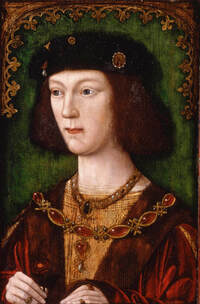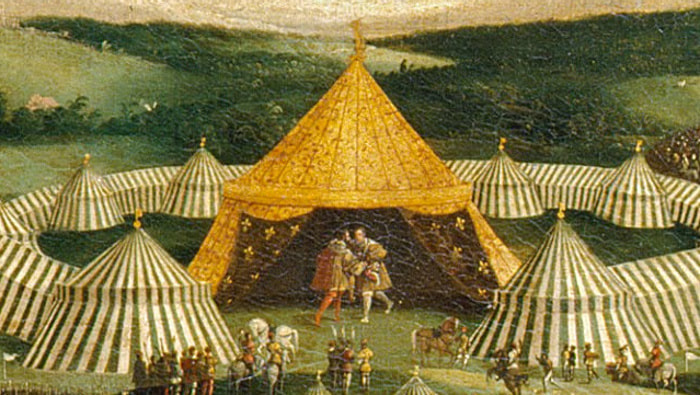Thomas Wolsey the Man
|
Henry VIII was seventeen years old when he became King of England after the death of his father, Henry VII, in April 1509. Until the death of his older brother, Arthur, in 1502, he had not expected to be the royal ruler of England.
With the pope’s authority, the adolescent new king was married to his brother’s widow, Catherine of Aragon, who was six years older than Henry, on 11 June 1509. ‘The king is young’, lamented the Spanish ambassador in England, ‘and does not care to occupy himself with anything but the pleasures of his age. All other affairs he neglects.’ At first the young king’s father’s aged contemporaries conducted government, but soon they became dominated by a younger and ruthlessly ambitious clerical man, Thomas Wolsey. Continued Below |
|
|
|
|
|
The houses of Trastámar (from which Catherine of Aragon descended), Habsburg and Valois were the principal ruling dynasties in Europe, and bloody and expensive wars were waged between them. In 1518, Pope Leo X launched an enterprise to bring a lasting peace to Christendom, but Wolsey, using his authority as papal legate, usurped the pontiff’s initiative and supplanted it with a pact of his own design, the Treaty of London.
The following year, however, Maximilian, head of the Habsburg dynasty and Holy Roman Emperor, died. His grandson, nineteen-year-old Charles V, who was already (by his maternal Trastámar inheritance) King of Spain, inherited Maximilian’s Habsburg domains and thus Trastámar and Habsburg united to become a vast empire.
The following year, however, Maximilian, head of the Habsburg dynasty and Holy Roman Emperor, died. His grandson, nineteen-year-old Charles V, who was already (by his maternal Trastámar inheritance) King of Spain, inherited Maximilian’s Habsburg domains and thus Trastámar and Habsburg united to become a vast empire.
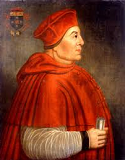 Thomas Wolsey
Thomas Wolsey
The title of Holy Roman Emperor, the holder of which was guardian of the Roman Catholic Church, was decided by election, and it fell vacant upon Maximilian’s death.
By this time, twenty-five-year-old Francis I had been King of France for four years. The union of Trastámar and Habsburg territories now surrounded France – save control of the Strait of Dover. In an effort to rebut Charles’s escalation of power, Francis set himself against Charles for election as Holy Roman Emperor.
Francis lost the election, and thereafter followed an escalation of the intense and bloody rivalry between Habsburg and Valois.
Cardinal Wolsey exploited the tradition that Holy Roman Emperors elect were first crowned King of the Germans at Aachen Cathedral in Germany. Charles lived in Spain, and safe passage between his domains was essential. Wolsey invited Charles to visit England as he sailed from Spain for the coronation. Charles then, appointed his former tutor, the trusty Adrian of Utrecht, as his regent in Spain and set off for Germany via England. Guarded in the Channel by the English fleet, he was protected from French hostility.
By this time, twenty-five-year-old Francis I had been King of France for four years. The union of Trastámar and Habsburg territories now surrounded France – save control of the Strait of Dover. In an effort to rebut Charles’s escalation of power, Francis set himself against Charles for election as Holy Roman Emperor.
Francis lost the election, and thereafter followed an escalation of the intense and bloody rivalry between Habsburg and Valois.
Cardinal Wolsey exploited the tradition that Holy Roman Emperors elect were first crowned King of the Germans at Aachen Cathedral in Germany. Charles lived in Spain, and safe passage between his domains was essential. Wolsey invited Charles to visit England as he sailed from Spain for the coronation. Charles then, appointed his former tutor, the trusty Adrian of Utrecht, as his regent in Spain and set off for Germany via England. Guarded in the Channel by the English fleet, he was protected from French hostility.
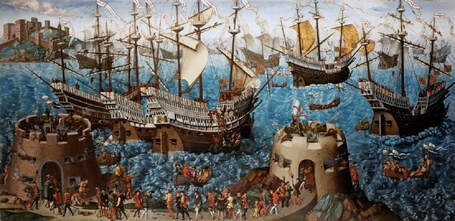 Wolsey's Maritime Spectacular
Wolsey's Maritime Spectacular
Charles arrived just as an enormous maritime logistics spectacle, arranged by Wolsey, was underway in the ‘narrow sea’ between Dover and Calais. The display was part of the preparations for the famous meeting between Henry VIII and Francis I known as the Field of the Cloth of Gold.
Wolsey had shown himself to be the de facto ruler of England, and he set out to imbue these two young monarchs with a lasting impression. He left them in no doubt about the strength of the English navy in the narrow sea.
Having been made welcome during his stay, the emperor then continued to Germany and his coronation.
The newly crowned Holy Roman Emperor was still in his northern territories when Wolsey’s London peace treaty was breached, and the cardinal reappointed himself the peacemaker.
At a clandestine meeting with Charles in Bruges, he reinforced his position as a critical ally if the emperor were to be an effective ruler of geographically distant lands. Wolsey would pledge his support to Charles and arrange his safe passage back to Spain through the Strait of Dover. Wolsey also agreed to make war on Francis in the north of France to draw his forces away from Charles' ambitions in the south.
In return, Charles would secure Wolsey's election as pope, by force if needs be.
Shortly afterwards Pope Leo X died, but it was not Wolsey who became pope but the trusty Adrian. He became Pope Adrian VI.
Wolsey had shown himself to be the de facto ruler of England, and he set out to imbue these two young monarchs with a lasting impression. He left them in no doubt about the strength of the English navy in the narrow sea.
Having been made welcome during his stay, the emperor then continued to Germany and his coronation.
The newly crowned Holy Roman Emperor was still in his northern territories when Wolsey’s London peace treaty was breached, and the cardinal reappointed himself the peacemaker.
At a clandestine meeting with Charles in Bruges, he reinforced his position as a critical ally if the emperor were to be an effective ruler of geographically distant lands. Wolsey would pledge his support to Charles and arrange his safe passage back to Spain through the Strait of Dover. Wolsey also agreed to make war on Francis in the north of France to draw his forces away from Charles' ambitions in the south.
In return, Charles would secure Wolsey's election as pope, by force if needs be.
Shortly afterwards Pope Leo X died, but it was not Wolsey who became pope but the trusty Adrian. He became Pope Adrian VI.
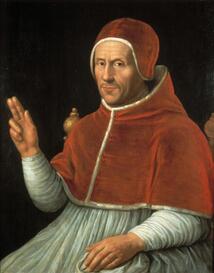 Pope Adrian VI
Pope Adrian VI
The time came for Charles to return home to Spain, and as agreed at Bruges, the English navy would again protect the emperor from French hostility in the Channel. Charles had pacified Wolsey, Adrian was an aged stand-in and would not last long in the papal office. He promised he would secure Wolsey’s election as pope at the next opportunity.
The Bruges agreement called for England and the Habsburg Empire to join forces and declare war on France, and this began with attacks on French naval ports as Charles sailed through the Channel.
Wolsey had honoured his side of the bargain and Charles sailed safely back to Spain.
A joint land invasion of France began in 1523, however, during that incursion, as the Duke of Suffolk was about to attack Paris, news came that the aged Adrian was dead.
The new pope was Giulio di Giuliano de' Medici, Pope Clement VIII and not the English cardinal.
Wolsey was incandescent. He was full of rage, a man set on bloody revenge against the emperor. For him, this was a betrayal in the first degree.
Without a word to Henry VIII, Wolsey changed sides from the Habsburg Charles to the Valois Francis. He embarked on an alliance to build a Valois-backed initiative to make him pope, with French support; however, in so doing, he severed the supply line to Brandon and left him stranded south of the River Somme, just when Paris had been ripe for the taking.
The Bruges agreement called for England and the Habsburg Empire to join forces and declare war on France, and this began with attacks on French naval ports as Charles sailed through the Channel.
Wolsey had honoured his side of the bargain and Charles sailed safely back to Spain.
A joint land invasion of France began in 1523, however, during that incursion, as the Duke of Suffolk was about to attack Paris, news came that the aged Adrian was dead.
The new pope was Giulio di Giuliano de' Medici, Pope Clement VIII and not the English cardinal.
Wolsey was incandescent. He was full of rage, a man set on bloody revenge against the emperor. For him, this was a betrayal in the first degree.
Without a word to Henry VIII, Wolsey changed sides from the Habsburg Charles to the Valois Francis. He embarked on an alliance to build a Valois-backed initiative to make him pope, with French support; however, in so doing, he severed the supply line to Brandon and left him stranded south of the River Somme, just when Paris had been ripe for the taking.
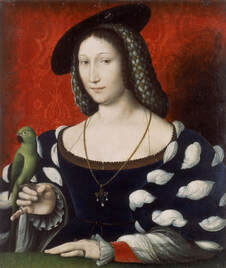 Marguerite d’Angoulême
Marguerite d’Angoulême
To maintain his papal ambitions, the cardinal must rid Henry VIII of his queen, Catherine of Aragon. Ostensibly, Henry and Catherine were happy in their marriage, but Charles V was Catherine’s nephew and so now, to the chameleon cardinal, she was a liability – she had no place in his alliance with the French. Henry must divorce her for a French wife.
Wolsey’s change of allegiance to the Valois King of France and his family began with near disaster when Francis was captured during the battle of Pavia and then held prisoner by Charles in Spain. Wolsey, however, was quick to take advantage and formed a bond with Francis’s mother, Louise, and his sister, Marguerite d’Angoulême.
Wolsey began a process of tireless work in support of the French negations for Francis’s release, and his efforts unified the two nations against Charles. Francis was eventually freed and, as soon as he was back on French soil, he formed a league against Charles.
Cardinal Wolsey and Francis had set themselves together as bitter enemies of Charles.
Wolsey probably had Francis’s sister, Marguerite d’Angoulême, in his mind to marry Henry, but the French princess was too shrewd for that ploy and instead, with a little genealogical conjuring, nominated her protégé Anne de Boulogne.
Wolsey’s change of allegiance to the Valois King of France and his family began with near disaster when Francis was captured during the battle of Pavia and then held prisoner by Charles in Spain. Wolsey, however, was quick to take advantage and formed a bond with Francis’s mother, Louise, and his sister, Marguerite d’Angoulême.
Wolsey began a process of tireless work in support of the French negations for Francis’s release, and his efforts unified the two nations against Charles. Francis was eventually freed and, as soon as he was back on French soil, he formed a league against Charles.
Cardinal Wolsey and Francis had set themselves together as bitter enemies of Charles.
Wolsey probably had Francis’s sister, Marguerite d’Angoulême, in his mind to marry Henry, but the French princess was too shrewd for that ploy and instead, with a little genealogical conjuring, nominated her protégé Anne de Boulogne.
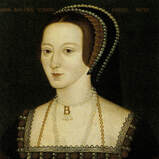 Anne Boleyn
Anne Boleyn
The cardinal convinced Henry and Anne that he could secure a divorce sanctioned by the pope. After the Sack of Rome in 1527, Pope Clement fled to the clifftop hideaway of Orvieto, in south-western Umbria.
In reality, the only way that a divorce could be obtained was with Wolsey as pope with French backing. Catherine of Aragon was Charles' aunt. Charles was the Holy Roman Emperor, and the Holy Roman Emperor controlled the pope who his prisoner on a remote hill top.
During the pope’s exile therefore, Wolsey advocated that papal authority should be transferred to him, which would have given him the mandate to rule as he wished concerning Henry’s marriage. Wolsey went to France and incited the opposing sides on mainland Europe, but, while he was away, the de Boulogne faction tightened its controlling grip on Henry. Anne, her father and her brother – aided by Louise and Marguerite d’Angoulême and Francis – gradually they stole the naive king from Wolsey, manoeuvring him into their clutches.
Wolsey dashed home – he must at least delay if not scupper the divorce and remarriage entirely – but it was too late; he had over-reached himself.
In reality, the only way that a divorce could be obtained was with Wolsey as pope with French backing. Catherine of Aragon was Charles' aunt. Charles was the Holy Roman Emperor, and the Holy Roman Emperor controlled the pope who his prisoner on a remote hill top.
During the pope’s exile therefore, Wolsey advocated that papal authority should be transferred to him, which would have given him the mandate to rule as he wished concerning Henry’s marriage. Wolsey went to France and incited the opposing sides on mainland Europe, but, while he was away, the de Boulogne faction tightened its controlling grip on Henry. Anne, her father and her brother – aided by Louise and Marguerite d’Angoulême and Francis – gradually they stole the naive king from Wolsey, manoeuvring him into their clutches.
Wolsey dashed home – he must at least delay if not scupper the divorce and remarriage entirely – but it was too late; he had over-reached himself.
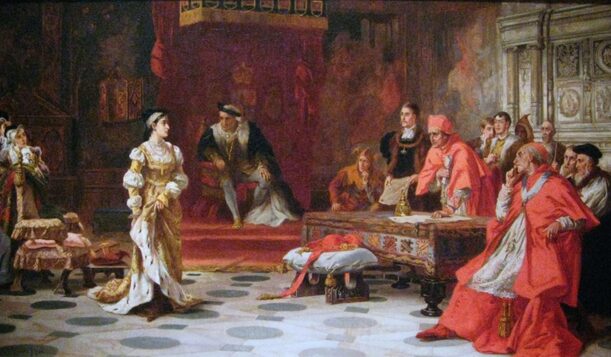 The Blackfriars Trial of Henry VIII's Marriage to Catherine of Aragon
The Blackfriars Trial of Henry VIII's Marriage to Catherine of Aragon
The Blackfriars trial of Henry VIII’s marriage to Catherine famously collapsed without a decision in July 1529. Wolsey had failed his king. The legal arguments were an irrelevance anyway, they always had been. Wolsey’s only chance, and remote one at that, of succeeding with papal sanction for the divorce was to obtain the papacy for himself. Catherine was Charles’s aunt. Charles was the most powerful man in Christendom, and he was guardian of the pope. Even if hell were to freeze over he still would not have allowed such a humiliation to be inflicted on his family.
Worse, for Wolsey, his machinations on the Continent were foiled by Archduchess Margaret (aunt of Charles V) and Louise de Valois (mother of Francis I), who saw through his treacherous schemes and united. To the exclusion of the cardinal, they negotiated a peace agreement between nephew and son, the so-called Ladies’ Peace, or Paix des Dames.
Wolsey had fallen between two stools and he was done for.
However, the ramifications of the over-reaching megalomaniac cleric’s actions amounted to significantly more even than creating discord between monarchs. The cardinal’s exploitation of the power he had filched from the church had incensed swathes of the English population.
Worse, for Wolsey, his machinations on the Continent were foiled by Archduchess Margaret (aunt of Charles V) and Louise de Valois (mother of Francis I), who saw through his treacherous schemes and united. To the exclusion of the cardinal, they negotiated a peace agreement between nephew and son, the so-called Ladies’ Peace, or Paix des Dames.
Wolsey had fallen between two stools and he was done for.
However, the ramifications of the over-reaching megalomaniac cleric’s actions amounted to significantly more even than creating discord between monarchs. The cardinal’s exploitation of the power he had filched from the church had incensed swathes of the English population.
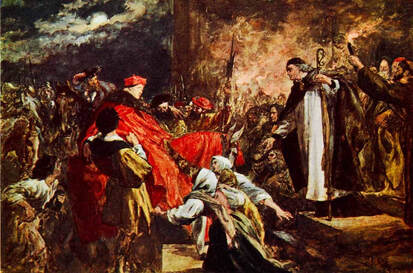 Infirmed - Wolsey was carried into Leicester Abbey
Infirmed - Wolsey was carried into Leicester Abbey
Thus, the papal prestige that he was trying to reignite they now sought to suffocate with an anti-clerical dogma.
Anti-clericalism in this context concerned a rejection of clerical interference in secular matters and specifically of interference from a foreign power. Over previous centuries, the English Parliament had introduced legislation (such as the Statutes of Mortmain, Praemunire and Provisors) to combat such interventions, but the laws had become dormant over the past century or so. Now some of their content was about to be reinforced, with spectacular consequences.
Anti-clericalism had reached its zenith in England at the turn of the fifteenth century, and to repress its expansion Henry V had led a diversionary war against France. It had remained a latent force throughout the consequent Wars of the Roses – but Wolsey had woken it up.
The period of hibernation was over. With Wolsey’s fall, the anti-clericalists, and there were very many of them, seized the moment. On 9 August 1529, within days of the collapse of the Blackfriars trial, the first of the Reformation Parliaments – the so-called anti-clerical Commons – was summoned.
Wolsey was banished to the his Archbishopric of York but in the autumn of 1530 he was arrested ther and ordered to return to London and face a charge of Treason.
On the journey south Wolsey died at Leicester Abbey on 29 November 1530.
Anti-clericalism in this context concerned a rejection of clerical interference in secular matters and specifically of interference from a foreign power. Over previous centuries, the English Parliament had introduced legislation (such as the Statutes of Mortmain, Praemunire and Provisors) to combat such interventions, but the laws had become dormant over the past century or so. Now some of their content was about to be reinforced, with spectacular consequences.
Anti-clericalism had reached its zenith in England at the turn of the fifteenth century, and to repress its expansion Henry V had led a diversionary war against France. It had remained a latent force throughout the consequent Wars of the Roses – but Wolsey had woken it up.
The period of hibernation was over. With Wolsey’s fall, the anti-clericalists, and there were very many of them, seized the moment. On 9 August 1529, within days of the collapse of the Blackfriars trial, the first of the Reformation Parliaments – the so-called anti-clerical Commons – was summoned.
Wolsey was banished to the his Archbishopric of York but in the autumn of 1530 he was arrested ther and ordered to return to London and face a charge of Treason.
On the journey south Wolsey died at Leicester Abbey on 29 November 1530.
|
|
|
|
